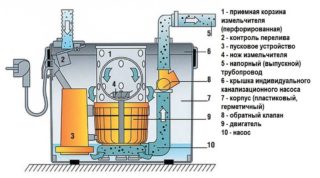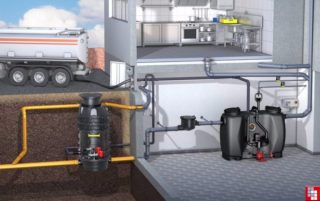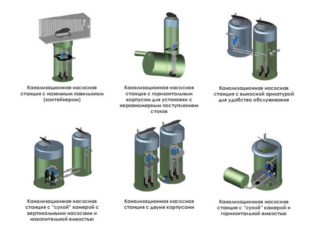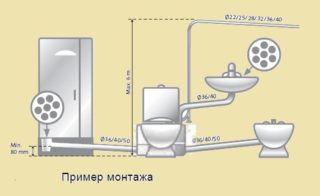It is important not only to properly lay the sewer pipes and connect them to the septic tank. It is necessary that the drains go to the sump in a timely manner and do not create problems in the form of an unpleasant odor in the house. In some cases, it may be necessary to install a sewage pumping station for domestic wastewater. Pumps are different in design, power, method of operation. Before going to the store, you need to have some understanding of these units in order to ask the right questions to the manager. It may be necessary to bring a plan of the sewer line in order to select a pumping station that meets all the requirements.
Purpose of a pumping station for a private house

A sewage pumping station for a private house is an additional device that consumes electricity, so residents try to equip gravity systems so as not to pay extra. This is possible in cases where the septic tank is located below the house, and the pipes can be laid at a slope, since the length of the line is short.
If the sewage pit for some reason is higher than the house, the waste will not be able to flow independently. The bathroom can be located in the basement, so the drains must first be raised, and then they will enter the main pipe and then flow independently. The same situation is when there is an obstacle in the path of the sewer pipes. The close location of groundwater does not allow observing the required slope, therefore, the section of the highway is forced to be located vertically. In all these cases, it is necessary to create an increased pressure so that the liquid does not stagnate in the pipes. In winter, this can lead to the formation of ice plugs and the sewer cannot be used.
Wastewater contains large particles, which, at low travel speeds, accumulate in the pipe and block it. This happens in those areas where the line turns or its diameter changes. In difficult terrain, it is difficult to lay pipes in a straight line - you have to bend around buildings or obstacles.
Principle of operation and main components

Sewage pumping stations can be divided into domestic and industrial. Industrial devices are complex engineering equipment that makes no sense to install in home systems, since their performance is much higher than the volume of a private house.
For private buildings, units of medium complexity are provided. They are small and compact. The type of wastewater is taken into account - waste from the toilet, containing large particles, kitchen waste and wastewater from the washing machine usually ends up in the household sewer.
SPS consists of the following main units:
- a pump or several units of a similar type;
- storage tank.
The pump can be installed directly at the exit from the house or behind the toilet. Such mini models have a neat appearance and fit well into the interior of the bathroom.
The storage tank can be compact in size or be designed for an entire multi-storey building or even a village.
The principle of operation is as follows: the liquid coming from plumbing devices is collected in a storage tank.When a certain level is reached, one or more pumps are triggered and the wastewater is discharged into the sewer pipes. The process is automated, so there is no need to constantly turn on the equipment.
The pipes are equipped with non-return valves to prevent odor and liquid from getting back into the house. Garbage is retained in the receiving basket, from where it is taken out during maintenance and routine cleaning.
The station can operate in three modes:
- at normal times, when the amount of wastewater does not exceed the norm, one pump is activated;
- at rush hour, when all the residents of the house are using water, both pumps or all units that are inside the storage tank are turned on;
- emergency mode - in the event of a large amount of water entering or the failure of both units, an alert signal is turned on that the station cannot cope with the load.
Manual control is also possible, in which the pumping equipment is started by pressing a button.
Types of SPS for a private house
The second type of SPS is larger and more powerful. It is a septic tank with a submersible pumping mechanism, which is turned on when it is necessary to clean the container and send the wastewater to the city sewer or sewer truck.
The third option is the most common. This is a stationary device equipped with 2 - 3 submersible pumps, which removes wastewater outside the house into a drain pit. From there, with the help of fecal aggregates, the liquid is pumped into the next septic tank for filtration through the soil.
Criterias of choice
To drain the waste fluid from the house, a small stationary model is installed. Its capacity should be comparable to the number of points of use of water - a bathroom, toilet, washing or dishwasher, sinks, swimming pool or sauna. They are selected according to the parameters of power and volume of the storage tank. It is better if the pump station is equipped with two pumps.
For the functioning of the sewerage system of a multi-storey building, you will need a large storage tank and several units that will pump out liquid. An important point is the presence of a cutting mechanism. It is best to have one, as debris and large debris can clog the outlet pipe.
Calculations
When buying a complete pump station, there is no need to buy a very expensive device that will operate at 10% of the declared capacity. A station is selected based on the following indicators:
- equipment dimensions - should be suitable for the room in which the installation is planned, for a private house it will be an ordinary household appliance that can be placed on an area of 1 sq. m;
- the expected flow of waste fluid - depends on the number of residents and the volume of water consumed during rush hour;
- the distance to which the liquid must be removed;
- the height of the inlet and outlet pipes;
- equipment performance based on the degree of sewage pollution.
A household SPS can be independently connected, while dimensional devices are formed from several parts designed for specific working conditions.
Installation features
Another thing is to install a sewer station for a country house. It is better to invite professional craftsmen for these works. Here, accuracy and correct selection of components, as well as their final adjustment, are important. The sequence of actions is also important. A person who does not have experience and does not understand the nuances of devices will not be able to carry out the installation correctly and will lose the manufacturer's warranty.
Operation and maintenance
Maintenance of household stations located in the house should be carried out regularly. The pump may clog if it is not equipped with cutting blades. The work is performed by a specialist of the service center. If you carefully observe his actions, you can subsequently inspect and clean the unit yourself.
The sewage pumping station of a private house also requires regular maintenance, but it is forbidden to go down into the sewage tank yourself. Poisonous gases can cause unconsciousness and death by asphyxiation.
Advantages and disadvantages of SPS
The advantage of the sewage pumping station is that it improves the operation of the entire sewage system, eliminating odors and preventing the backflow of drains. At the same time, the equipment needs frequent maintenance, which involves financial investments.
Prices for sewage pumping units are high. The cost of the device depends on the brand of the manufacturer, the materials from which the main units are made, as well as the complexity of the design. Correctly installed equipment will last about 10 years. Cheaper devices from unknown manufacturers are much smaller.










